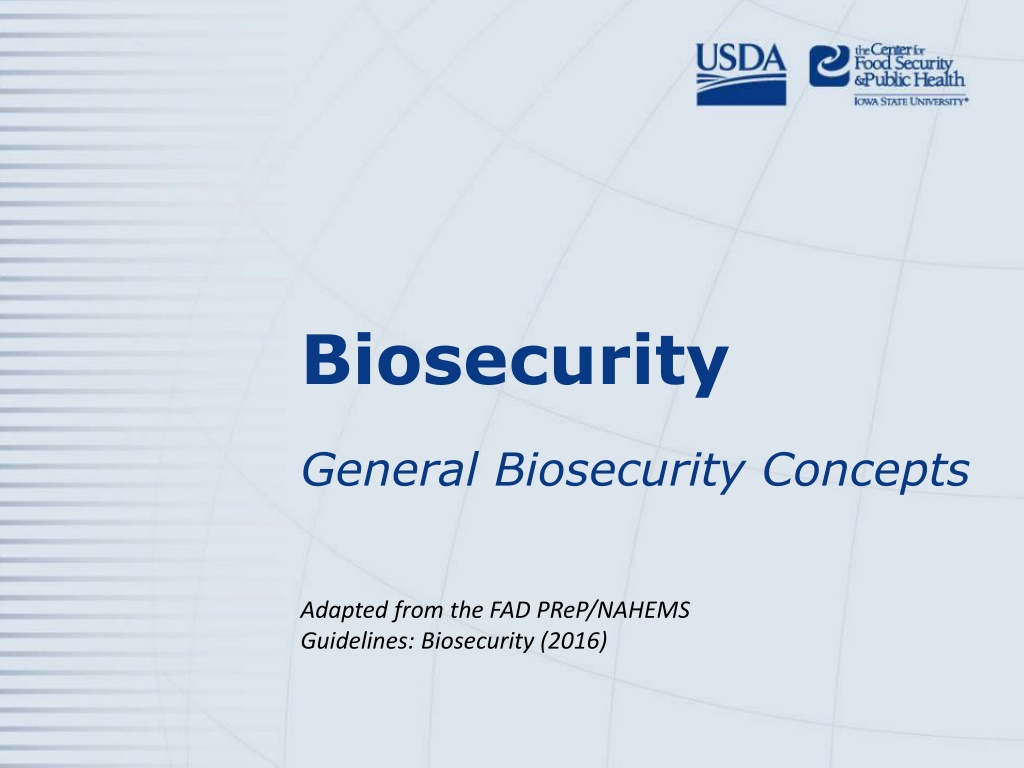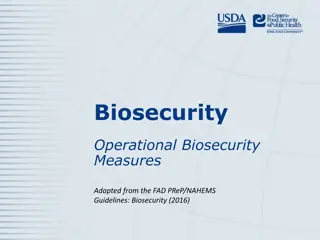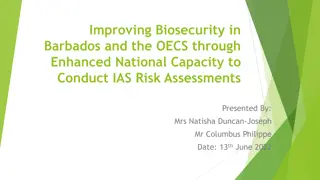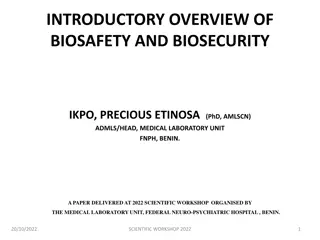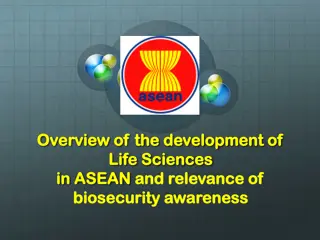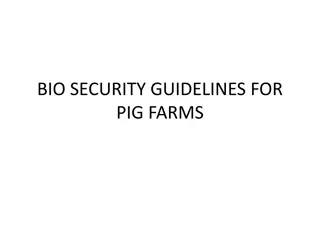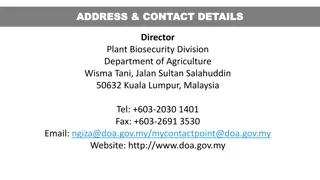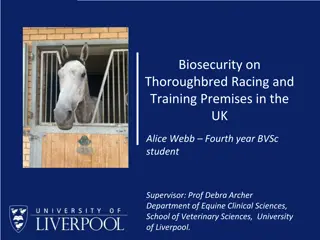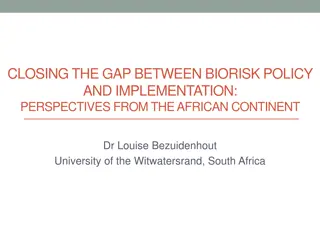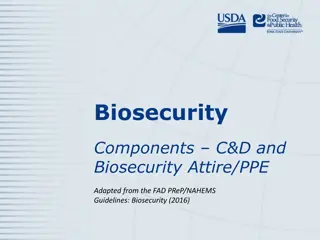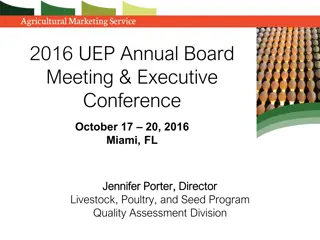Understanding Biosecurity Concepts for Disease Prevention
Explore the crucial aspects of biosecurity for disease prevention, including the importance of biosecurity, routes of disease exposure, developing a biosecurity plan, and key concepts such as risk assessment, hazard analysis, and critical control points. Learn how to prioritize biosecurity measures to prevent the spread of diseases and protect animals from foreign animal diseases.
Download Presentation

Please find below an Image/Link to download the presentation.
The content on the website is provided AS IS for your information and personal use only. It may not be sold, licensed, or shared on other websites without obtaining consent from the author. Download presentation by click this link. If you encounter any issues during the download, it is possible that the publisher has removed the file from their server.
E N D
Presentation Transcript
Biosecurity General Biosecurity Concepts Adapted from the FAD PReP/NAHEMS Guidelines: Biosecurity (2016)
This Presentation Importance of biosecurity Routes of exposure to disease Steps in developing a biosecurity plan Introduction to 3 levels of biosecurity Conceptual Structural Operational FAD PReP/NAHEMS Guidelines: Biosecurity - Concepts USDA APHIS and CFSPH
Importance of Biosecurity Collection of management practices Prevent introduction/spread of disease Routine and emergency measures Avert severe, negative impacts of a foreign animal disease (FAD) Strategic decisions and adequate investment in management practices FAD PReP/NAHEMS Guidelines: Biosecurity - Concepts USDA APHIS and CFSPH
General Concepts Risk assessment hazard analysis Identify sources of potential infection Identify areas needing protection Establish Line of Separation Dirty (contaminated)/clean (protected) Ascertain site-specific pathways for potential disease movement Prioritize biosecurity measures FAD PReP/NAHEMS Guidelines: Biosecurity - Concepts USDA APHIS and CFSPH
General Concepts contd Identify critical control points Any point, step, or procedure to apply control (to prevent harm) Prevent the transfer of a pathogen from entering or leaving Involve people, supplies, equipment, vehicles, feed, mortalities, animals, and animal products Bioexclusion and/or biocontainment FAD PReP/NAHEMS Guidelines: Biosecurity - Concepts USDA APHIS and CFSPH
Routes of Exposure to Disease FAD PReP/NAHEMS Guidelines: Biosecurity - Concepts USDA APHIS and CFSPH
Exposure Direct, Aerosol Direct Contact Direct transfer Skin, mucous membranes, and open wounds Rubbing, biting, licking, or contact with body fluids (nose-to-nose) Aerosol Inhalation Infectious droplets FAD PReP/NAHEMS Guidelines: Biosecurity - Concepts USDA APHIS and CFSPH
Exposure Oral, Fomites Oral Ingested, consumed Licking, biting, and eating feed Environment contaminated by feces, urine, saliva, and blood Fomites Inanimate objects Equipment, vehicles, clothing and boots, dust, and feathers Lateral spread between facilities as people move FAD PReP/NAHEMS Guidelines: Biosecurity - Concepts USDA APHIS and CFSPH
Exposure Vectors, Zoonotic Vectors Living organisms Arthropods, insects, rodents, feral animals, and scavengers Biological and mechanical Zoonotic Disease Exposure may occur through any of the routes Disease-specific FAD PReP/NAHEMS Guidelines: Biosecurity - Concepts USDA APHIS and CFSPH
Developing a Biosecurity Plan FAD PReP/NAHEMS Guidelines: Biosecurity - Concepts USDA APHIS and CFSPH
Developing a Plan Step 1: Prioritize the disease agents Consider species/susceptibility, housing, management, wildlife exposure Step 2: Conduct a facility assessment Identify pathways/movements Step 3: Implement processes to minimize impact of disease Prevent movements that carry disease FAD PReP/NAHEMS Guidelines: Biosecurity - Concepts USDA APHIS and CFSPH
Developing a Plan contd Movements of animals Closed herd is more protected Additions from offspring within the herd Managed in small, isolated groups All-in/all-out management, less co- mingling Animals that leave and return create a risk for the herd/flock Quarantines restrict movements FAD PReP/NAHEMS Guidelines: Biosecurity - Concepts USDA APHIS and CFSPH
Levels of Biosecurity - Preventing Exposure to Disease FAD PReP/NAHEMS Guidelines: Biosecurity - Concepts USDA APHIS and CFSPH
Prevent Exposure to Disease Producers are responsible Effective day-to-day procedures Biosecurity is an investment Protocols are specific Species/mixture of species Diseases, susceptibility to disease Intended purpose, economic value Practicality, facility lay-out FAD PReP/NAHEMS Guidelines: Biosecurity - Concepts USDA APHIS and CFSPH
Increased Risk of Exposure Farm density Animal movement Traffic on and off the premises Human activity Equipment sharing Access by wildlife Housing difficult to clean Mortality disposal near animal housing FAD PReP/NAHEMS Guidelines: Biosecurity - Concepts USDA APHIS and CFSPH
Three Levels of Biosecurity Conceptual Location, geospatial siting, orientation of the facility Structural Capital investment, construction, to prevent disease spread Operational Processes, management practices, standard operating procedures to exclude or contain disease FAD PReP/NAHEMS Guidelines: Biosecurity - Concepts USDA APHIS and CFSPH
Conceptual Biosecurity Facility location, geospatial siting, orientation, scope, size Higher risk Greater farm density, close to wildlife areas, large groups managed as one population Best practices Separation, isolation Small biosecure units Distance to wildlife habitats and roads FAD PReP/NAHEMS Guidelines: Biosecurity - Concepts USDA APHIS and CFSPH
Conceptual Biosecurity contd Evaluate existing facility Mitigate/compensate for vulnerabilities: Eliminate (make less attractive) wildlife habitat Reroute traffic away from animal areas Create smaller biosecure groups FAD PReP/NAHEMS Guidelines: Biosecurity - Concepts USDA APHIS and CFSPH
Structural Biosecurity Construction, capital investment Physical design and maintenance Paved parking away from barns Fences, barriers leading to entrances to conduct biosecurity protocols Locations for cleaning/disinfecting On-site laundry for outerwear Specialized anteroom at entry FAD PReP/NAHEMS Guidelines: Biosecurity - Concepts USDA APHIS and CFSPH
Structural - Danish Entry System Example of a Danish Entry System Specialized anteroom Prompts biosecurity protocols Entering and leaving Enhancements in long term plans FAD PReP/NAHEMS Guidelines: Biosecurity - Concepts USDA APHIS and CFSPH
Operational Biosecurity Processes, management practices, standard operating procedures to exclude or contain disease On-farm movements and managements People, animals, supplies, equipment, vehicles, and other items Based on specific risk assessments Mitigation of conceptual and structural vulnerabilities, and known disease FAD PReP/NAHEMS Guidelines: Biosecurity - Concepts USDA APHIS and CFSPH
Operational Biosecurity contd Apply strategic actions at critical control points Focus on inputs and outputs Entrances and exits Work paths Processes Clearly identify separation of clean/dirty FAD PReP/NAHEMS Guidelines: Biosecurity - Concepts USDA APHIS and CFSPH
Operational Biosecurity contd Clean versus dirty Line of Separation Perimeter Buffer Area Implement at farm or barn level Mapped and physically marked Crossing point = critical control point FAD PReP/NAHEMS Guidelines: Biosecurity - Concepts USDA APHIS and CFSPH
Operational Biosecurity contd Cleaning/disinfection and biosecurity attire/PPE People, equipment, vehicles Vectors Carcass disposal Manure/litter management Water sources Delivery/storage of feed and bedding Maintenance and security FAD PReP/NAHEMS Guidelines: Biosecurity - Concepts USDA APHIS and CFSPH
Conclusion Biosecurity protects animal health Develop a site-specific biosecurity plan Consider disease characteristics such as routes of exposure Incorporate 3 levels of biosecurity: conceptual, structural, operational FAD PReP/NAHEMS Guidelines: Biosecurity - Concepts USDA APHIS and CFSPH
For More Information FAD PReP/NAHEMS Guidelines & SOP: Biosecurity (2016) http://www.aphis.usda.gov/fadprep Biosecurity web-based training module: http://naherc.sws.iastate.edu/ FAD PReP/NAHEMS Guidelines: Biosecurity - Concepts USDA APHIS and CFSPH
Guidelines Content Authors (CFSPH) Janice P. Mogan, DVM Heather Allen, PhD, MPA Kristen Bretz, MS Reviewers (USDA) Jonathan T. Zack, DVM James A. Roth, DVM, PhD, DACVM FAD PReP/NAHEMS Guidelines: Biosecurity - Concepts USDA APHIS and CFSPH
Acknowledgments Development of this presentation was by the Center for Food Security and Public Health at Iowa State University through funding from the USDA APHIS Veterinary Services PPT Authors: Janice P. Mogan, DVM; Logan Kilburn Reviewer: Kristen Bretz, MS
